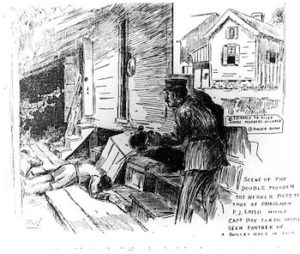
Riot sketch
*The Robert Charles Riots began on this date in 1900. It occurred for three days in New Orleans, Louisiana, after a Black laborer, Robert Charles, fatally shot a white police officer during an altercation and escaped arrest.
Charles had come to New Orleans from Mississippi. He was a self-educated activist for American civil rights. He believed in self-defense for the black community and encouraged blacks to move to Liberia to escape racial discrimination and violence. On the evening of July 23, 1900, three white police officers, Sergeant Jules C. Aucoin, August T. Mora and Joseph D. Cantrell investigated reports of "two suspicious-looking negroes" sitting on a porch in a predominantly white neighborhood. They found Robert Charles and his roommate, 19-year-old Leonard Pierce, at the scene.
The policemen questioned the two men; Charles stood up, which the police took as an aggressive move. Mora grabbed him, and the two struggled. Mora and Charles pulled guns and exchanged shots; both men received non-lethal gunshot wounds to the legs. Charles fled to his residence, leaving a trail of blood. Pierce, also armed, was covered by a police officer when Charles ran. Charles returned to his residence early the next morning, approximately 3 am, on July 24, 1900.
When the police tried to apprehend Charles, he fired, fatally hitting Captain Day in the heart and another policeman, Peter Lamb, in the head. The remaining police officers took refuge in a nearby room, and Charles escaped. The police started a search, and a crowd of whites gathered on Fourth Street, where the police officers had been killed. There were shouts for lynching Charles, but the crowds dispersed when they were falsely told Charles had been located and jailed.
On July 25, Acting Mayor William L. Mehle announced a $250 reward for the arrest of Charles while issuing a proclamation urging peace. Historian William Ivy Hair described the scene: The mayor, knowing the mood of the city and fearing that some massive butchery of the black population might take place, called upon the state militia units, which had been mobilized since Thursday, to go to the scene with—and he made a special point of this—their two Gatling guns. Capdevielle declared that if things got completely out of hand, the Gatling guns should be fired into the white mob.
The police fired on the house throughout the day, where Charles returned fire from the second-story windows. By 5 pm, Charles had killed or fatally wounded five law officers and nineteen others. A fire captain and other volunteers snuck into the first floor beneath Charles and ignited a mattress. The smoke from the mattress forced Charles out of the house. As he tried to escape, he was shot by Charles A. Noiret, a medical student and member of the special police (a militia group of volunteer citizens).
The police officers continued to shoot Charles. When they dragged his body outside, a mob of bystanders beat his body. A total of 28 people were killed in the riots, including Charles. Over 50 people were wounded in the riots, including at least 11 who had to be hospitalized. Blacks made up most of the fatalities and casualties.